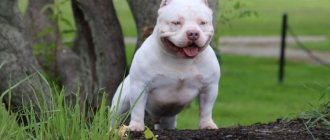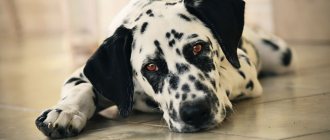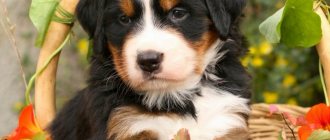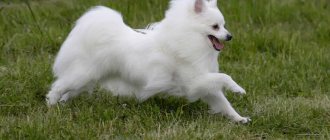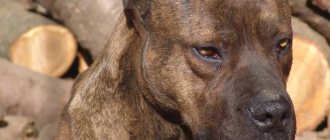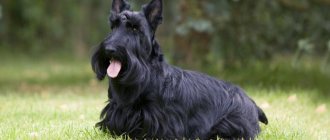Description and features
historical or documentary sources that would accurately confirm the history of the appearance of the Bully Kutta breed . Therefore, breeders can only speculate as to its origin. According to the most common version, the first owners of this dog were Persians. They used it for guard purposes.
An outsider could not approach the area guarded by a formidable beast. He was very strong and courageous, so he inspired fear and sometimes horror in potential enemies.
And the ancient representative of the breed helped the Persians in battle. They valued him for his speed, endurance and agility. The descendants of such dogs are very different from them. Breeders have worked for a long time to correct the aggressive traits of their character, thereby making such dogs more tame and controllable. Fortunately, they succeeded.
After Great Britain made India its colony, representatives of the breed in question began to be crossed with mastiffs and bull terriers. As a result of this breeding, a new type of dog was born. He has not lost his former power, but has become more contactable.
Interesting fact! From one of the eastern dialects, “bulli kutta” is translated as “wrinkled dog.” The animal received this name for a reason. The fact is that in the area of his neck and mouth there are sagging folds of skin, making him look like an accordion.
This is a very brave and strong animal. He doesn't lack courage. Due to the presence of such character traits, he is still exploited in battles. Unscrupulous breeders sell the largest and meanest puppies from the litter to the organizers of such events. Those, in turn, train them on people and animals, shaping the development of aggressive character traits.
This huge dog also shows ferocity when hunting. It is used for catching large game. The animal not only searches for prey by following the trail, it attacks it and can even kill it. By comparison, most hunting dogs never kill game, they find it or, at most, restrain it until the hunter arrives.
The main purpose of such a dog is to protect its owners and their estates. He bravely and vigilantly “patrolls” the territory in search of something suspicious. Yes, this dog can harm a person whom he suspects of evil intentions. That is why it is extremely important to pay special attention to her early education.
Interesting facts about bully cutts
In the ranking of “the strongest breed”, bully cutties take 4th place, behind the Kangal (Anatolian Shepherd), the Central Asian Shepherd - Alabai and the Caucasian Shepherd. However, they are not suitable as sled dogs or for carrying loads. Their remarkable quality can only be realized in battles.
In Russia, in 2021, a new, shortened list of dog breeds that pose a potential danger was approved. The list includes 10 breeds, including Bully Kuta. The criterion for selection was the purpose of the breed: dogs for fighting, baiting and local breeds that did not pass the selection for loyalty to people were considered dangerous. Walking such dogs without a muzzle and leash is prohibited. Bully cutties are included in the list of potentially dangerous breeds in Belarus. These animals are not on the list of Ukraine, which includes more than 30 breeds.
The use of dogs in combat has been practiced at least since the times of Ancient Egypt, and their activity flourished in ancient times. In Assyria and Persia 500 BC. They already used a special breed like mastiffs. It is believed that it was the Persian king Xerxes I who brought the ancestors of the Bulli Kutta (or Alanga) to India. In the state of Tamil Nadu (south India), in one of the temples of the 12th century there is a bas-relief depicting a snarling dog of a square format, similar to modern BK.
On the other hand, similar dogs are depicted next to Akbar the Great (1556-1601), the ruler of the Mughal Empire (central India and Pakistan). Court dogs, along with cheetahs, were used to hunt large game and to guard the palace and dungeons with prisoners.
Breeding fighting dogs has been prohibited in England, in New Zealand since 1991, in France since 1998, in Germany since 2001, in Israel since 2003, in Australia since 2005. In Sweden, Denmark, Italy and Spain prohibits not only breeding, but also the import of such breeds. There is no ban on breeding in Russia, but everything can change in a moment.
Breed standard
Let's start with the main thing. At the international canine level, the Bully Kutta dog is not standardized. Its parameters are still being carefully studied. This complexity is associated with the long history of formation and selection of the breed.
However, such a dog has unique exterior parameters. It is very large, growing up to 85-90 cm in height. It can weigh from 70 to 83 kg. Sometimes there are overgrown individuals. Their body weight is 90-95 kg.
The Pakistani Mastiff is well built and harmonious. He has a rectangular wide back. The stomach is sunken. The ribs on its lateral parts should be palpated and visible. If they are not visible, then the dog is clearly overfed.
Wide paw set. They are very long and slender. The pads are massive and hard. The peculiarity of the breed is the ability to maintain stability even on slippery surfaces. This is probably due to the hard pads of the feet. It also has long dark claws at the tips of its paws. The animal must grind them down, as the claws grow quickly.
He has strong thigh muscles, allowing him to quickly push off the ground to run or jump. The tail is thin, hangs evenly or may curl. The lower back is clearly visible, it is slightly convex. The neck is medium in length, quite thick.
The head of the Pakistani Mastiff is very large. Along its edges are poorly structured ears that should be cropped at 3 months. This is due to the fights in which the dog participates. But, if the owner of such a pet does not plan to register it for participation in such events, it is not necessary to crop its ears.
In this case, they will be medium in thickness, V-shaped in shape. The dog has fleshy, moist lips with pink gums. The jaw is very strong. She has a complete set of teeth. The nose is large, as are the eyes. The iris is most often brown or black.
Bulli kutta in the photo is depicted as strong, purposeful and interested. With his entire appearance he radiates power. Without a doubt, this is one of the strongest dogs. This massive dog cannot be called graceful and elegant. He treads rather heavily on the ground, his step lacks lightness and grace. Nevertheless, courage and strength emanate from him.
The Pakistani Mastiff has a short, bright coat. Can be any color: black, reddish-red, brown, etc. But the most common shade is pure white. The dog's fur is soft and pleasant to the touch.
Description of the breed
The Bully Cutta is not only a large, but also a beautiful dog with a well-developed chest, muscular neck and powerful skeleton. It has a huge head and a large, long snout with a strong set of teeth that form a scissor bite. Round, small ears are carried high, pigmentation is allowed on the nose.
Excess skin, especially under the chin and around the neck, is a distinctive feature of the breed and determines its name.
The dog's lips hang freely, they are constantly moist due to a significant amount of saliva.
The Bully Kutta has long, slender legs and strong joints; The paws are wide and round, with hard pads. With a soft, swaying step and graceful gait, the dog resembles a lion in movement.
The tail is long, gradually tapering, lowered at rest and should not lie on the back when excited.
The Bully Cutta has a two-layer, short and coarse coat, the predominant color is white, but there are dogs of black, fawn, red, brindle and merle, as well as white and brown, black and white. There may be options with small spots, similar to a polka dot dress.
It's hard to imagine a larger dog - they look very impressive:
- height at the withers is from 76 to 112 cm, and weight is from 68 to 90 kg for males;
- height from 71 to 91 cm and weight from 59 to 68 kg in females.
Depending on its habitat, the breed has several names. The most common ones are:
- Indian Mastiff;
- Pakistani Mastiff;
- bulli kutta;
- alangu mastiff;
- Pakistani Bully;
- Indian Bully.
But regardless of the name, the Bully Kutta is always a mastiff of enormous, even frightening size, an impressive physique with a strong, menacing voice.
Character
Bully Cutta is one of the most difficult breeds to train. Its representatives can be friendly and aggressive at the same time. The restless disposition of such a dog is associated with his fighting past. In addition, he was exploited for bloodthirsty hunting. Of course, this could not but affect his character.
The basic advantage of a dog is the complete absence of fear. She is very brave, purposeful and responsible. Remains vigilant in any situation. She can be careful, especially in extreme situations.
He becomes strongly attached to the human teacher. Sincerely loves him. Learns respect from childhood. He can behave excessively cocky if he doesn’t please him in some way, for example, he forces him to study or scolds him. Capable of attack. Therefore, most dog experts agree that the Pakistani mastiff is mentally unstable, and therefore should not be kept by people as a pet. Is it so?
On the one hand, this animal is extremely intolerant of strangers, especially persistent and unfriendly ones. He barks loudly at them, and if they decide to cross his territory, he will certainly attack. On the other hand, any dog of the fighting breed is prone to such behavior, therefore, they are too biased towards the Bully Cutta.
Important ! Only young representatives of the breed are prone to overly energetic and aggressive behavior. More mature individuals are calm, passive, but also observant and cautious, as they were in their youth.
Some veterinarians call Pakistani Mastiffs bully dogs. This is true. Representatives of this breed can indeed behave destructively, especially at an early age. That is why they need to start training as early as possible.
In most cases, this dog behaves too impulsively. He can run around the area without stopping and bark at people, thus warning them of his possible attack. Capable of even challenging the owner. Too self-confident and prone to dominant behavior. These animal character traits need to be corrected.
The reader may now have a false idea of the bully cutta as an inadequate and uncontrollable dog. In fact, even she is not without merit. The main advantages of a representative of this breed compared to others:
- Courage and bravery.
- Fearlessness.
- Determination.
- Strong attachment to the owner.
- Excellent mental abilities.
Nature certainly did not deprive the dog of intelligence. Despite laziness and obstinacy, he very quickly remembers the commands that his owner teaches him and tries to carry them out. As a guard and bodyguard, the Pakistani Mastiff is unrivaled.
Worth considering! Bulli Kutta is not suitable for families with small children. He cannot get along with someone who is weaker than him physically and mentally. Moreover, it can be very jealous of its owner towards his child.
Historical reference
The question of the origin of the Bully Cutta breed is still controversial: no one knows for sure where and when these huge and fearless dogs first appeared.
It may have originated in India or Pakistan back in ancient times, and Xerxes I () brought them with him when he headed to India as early as 486 BC.
Proponents of another theory believe that the British troops, who invaded the territory of Indo-Pakistan in the 1700s, took with them mastiffs and bulldogs, which subsequently crossed with other large local dogs. The second version has more supporters, but at the same time there is information that back in the day, dogs of this breed were used as guard dogs to protect herds, property and people, as well as to hunt large game, such as bears, wild boars, tigers, cheetahs and lions.
Like other dogs, the Bully Kutta was born to serve man, but their strength, endurance, fearlessness and ability to risk their lives became widely used in dog fighting, which was very popular in India and Pakistan.
In this blood sport, only the strongest dogs survived, trained through training and harsh methods to be aggressive and fight to the death against other ferocious dogs such as the pit bull, kangal, rottweiler and others.
With the adoption in many countries of the law banning dog fighting, opportunities for bully cuttas to realize their main purpose once again opened up - to protect people, their property, to serve a person, and not to serve his base inclinations.
Bully Cutta is a relatively rare breed. For many years it did not spread far from the places where it first appeared.
Only relatively recently, representatives of this breed were brought to China, Russia, the USA and Central Asia.
Maintenance and care
It is extremely difficult to get along with a huge fighting dog in a cramped apartment. She needs a lot of space to use her best qualities - speed, agility, maneuverability. The strength of a physically resilient dog must be maintained through sports. She should practice at least 1 hour a day. Therefore, if you are not sure that you can devote such time to her every day, it is better not to get such a dog at all.
It should be noted that Pakistani mastiffs who do not regularly engage in sports are more intolerant and angry. They definitely need loads! You can run cross-country or sprint with such dogs, throw them a ball and ask them to bring it, teach them to jump over a barrier, etc.
Even if you live in a country house, you will have to walk a representative of the breed twice a day. Be sure to put a muzzle on him. You can't let him off the leash. This is due to the law on walking aggressive dogs. Also, never ask anyone or acquaintances or friends to hold the leash while you are distracted by something.
If the mastiff realizes that its owner has lost his vigilance, he can take advantage of the situation and rush forward. It is very easy to care for. The requirements are standard. Firstly, the Bully Kutta should be combed so that its coat is renewed faster. This is done every week, and in the summer, more precisely during the molting season, every day.
Secondly, his teeth and fangs need to be cleaned of plaque so that tartar does not form on them. And thirdly, it should be washed with water every day. Bathing such a large dog is not easy. It is advisable to do this outdoors using a hose and shampoo. But his ears are washed separately and carefully. No water should get into them!
Nutrition
Massive and large dogs need to eat a lot to stay strong. They require a lot of fats, carbohydrates and protein. The last element is the most important; in the body of a living creature it performs a construction function. A bully cutta puppy should eat meat and drink milk every day.
These are two important products, the use of which will lay the foundation of the future immune system in his body. In addition, feeding a young dog protein food with microelements will allow her to quickly gain the necessary weight.
In addition to milk and meat, he should be fed cereals and fruits. As the Pakistani Mastiff gets older, he is switched to dry food. The daily norm for him is 700-800 grams, no less. List of foods prohibited for domestic dogs:
- Smoked meats.
- Salo.
- Bone fatty fish.
- Marmalade, cream cake, chocolate.
- Lollipops.
- Delicious baked goods.
- Spicy dishes.
The health of your pet depends to a large extent on proper nutrition.
Reproduction and lifespan
It is extremely rare for Bulli Kutta to live to be 12 years old. On average, they live no more than 8-9 years. If a dog is well and properly cared for, it will serve its owners faithfully. Large dogs are bred when they are at least 2 years old.
Previously, it was impossible. It is also not recommended to breed mature dogs over 7 years old. The best time for mating is the 3rd day from the day the female starts estrus. If she happens to a male during this period, she will probably become pregnant.
Price
There are very few purebred representatives of this ancient breed in Russia. In the vast majority of cases, breeders pass off bully mixes as purebred mastiffs, and they ask for a decent amount of money for them, from 50 thousand rubles.
If you want to purchase an absolutely healthy and “correct” dog of this breed in all respects, we advise you to go for it to its homeland, that is, to Pakistan. There they will ask for at least 30-40 thousand for it. The price of bulli kutta in other countries of the world can reach 60 thousand rubles.
Education and training
The main attention in raising such a serious dog must be paid to correcting its behavior pattern when interacting with others. It is important to teach him to communicate adequately with members of the household. Remember, a pet dog should under no circumstances be angry with anyone in his household.
From an early age, he learns to understand which people are included in his pack and which are strangers. He may be prejudiced and intolerant towards the latter, but only if his owner is not nearby.
The owner of a serious fighting dog should be guided by these simple rules for raising it:
- Be present while the Bully Cutta puppy eats. At this moment you need to pet him and talk to him. It would also be a good idea to touch his food and take it in your palm, and then offer the animal to eat from your hand. This way he will understand that it is not he who controls the food, but you, and therefore will be imbued with respect for you.
- If your dog bullies another pet, raise your voice at him. And if he tries to attack him, lightly slap him on the lower back, and then send him to the enclosure. The representative of the breed does not like loneliness and next time, in order to avoid it, he will be more tolerant.
- Don't let him fool around, ever. In order for the Pakistani Mastiff to be well managed, it should always be kept under control.
- Practice walking calmly together. The dog should not pull on the leash, break free, or lunge at everyone around him. He should silently walk next to his owner, trust him and not react to strangers. To do this, tighten the leash and practice walking together in the yard, stopping periodically.
Praise the Bully Kutta when he is aggressive towards strangers who come close to your home area. Reward him with delicious food. He should notify the owner of the arrival of a guest by barking. But if he tries to attack him, this should be condemned.
If you yourself let a guest into the house, drive the dog away; it can only come at your command. At the first sign of aggression towards a guest, lock him in an enclosure and do not let him out until he leaves.
Of course, unscrupulous owners can deliberately train Pakistani mastiffs to kill people and animals, turning them into “cold weapons.” Under no circumstances should you do this. Remember, a domestic dog, even a fighting breed, also needs affection and love. So don’t deny Bully Kutta attention and care.
Appearance and character
The Pakistani Mastiff is a large guard dog that is very rare in Europe and America. It is absolutely not suitable for beginners and inexperienced owners, as it requires a special approach to care and handling.
It should be noted that the modern appearance and character of the Bully Kutta breed was developed in India at the end of the last century, through crossing with the English mastiff, bull terrier and hunting dogs.
Find out more about representatives of hunting dog breeds in five parts: , , , , .
Description and photo
- Life expectancy: 8-10 years.
- Litter: 9-10 puppies.
- Group: fighting, guard.
- Coat color: white, brindle, brown, black.
- Coat length: short, double.
- Molt: no.
- Weight: 64-95 kg.
- Size: 71-112 cm at the withers.
Character of the fighter
For many decades, Bully Cutta dogs have been used as fighting dogs. This fact is quite firmly entrenched at the genetic level of the animal, which affects its character. It is important to note that such a dog is quite difficult to train, although they are intelligent and territorial.
In the East, the reputation of the Pakistani Mastiff is very clear: a bloodthirsty, ferocious and aggressive dog. They are not able to get along with other dogs and in case of “invasion of their territory” they can attack and kill intruders.
If you are a fan of big dogs, check out the nuances of keeping these breeds: Cane Corso, Siberian Husky, Alaskan Malamute, Moscow Watchdog, Hotosho, Doberman Pinscher, Giant Schnauzer, Samoyed, Newfoundland, German Shepherd, Pit Bull Terrier, Great Dane and Rottweiler.
Accordingly, they are absolutely unfriendly with other animals. You should also not get a representative of this breed if there are children in the house, as this is not a breed that can be teased and played with.
If the bully kutta is raised correctly, he grows up to be a reliable and responsible friend. They are fearless and very loyal to their owner, but only to one person.
Health issues
Representatives of the breed in question, who eat well, have excellent health. But, some of them suffer from hip dysplasia. Only veterinarians can help sick dogs. Also, Pakistani Mastiffs often suffer from tartar. The best and simplest prevention of its occurrence in domestic dogs is regular brushing of their teeth.
It should be noted that body parasites greatly annoy pets, especially fleas. They are poisoned all year round, especially if the animal lives on the street. Finally, a piece of advice - regularly monitor the health of the Bully Kutta so that he lives as long as possible.
History of the breed
The breed originates from Rajasthan and Bahawalpur. As is the case with many ancient breeds, the origins of the Pakistani Mastiff remain a mystery to this day. However, there are a large number of different versions of the appearance of bully kutta.
Did you know? Many residents of Rajasthan claim that the Pakistani mastiff is the heir to the first aboriginal dogs.
The most common theory about the origin of the Bully Kutta is the story of the Persian army, which used fighting dogs for attack and protection. This story refers to the Persian war under Xerxes, which took place between 486 and 465. BC.
One of the trophies after the victory over the invaders were watchdogs and fighting dogs. The Indian Maharaja immediately saw the ferocity and pressure of the Bully Kutta, as a result of which he began to use them as hunting dogs for large game.
In the future, cheetahs took over this role, and mastiffs became simple guards. The first images of the breed in question were captured during the reign of the Great Mongols, when Emperor Akbar resumed the use of mastiffs as hunters.
In modern times, bully cutta is used in dog fighting. Despite the law, since it prohibits this cruelty to animals, many rural areas of India and Pakistan continue to profit from this particular type of “entertainment”.
